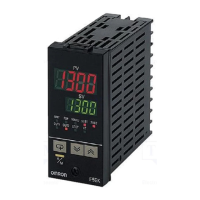CHAPTER 5 PARAMETERS
E5EK
5--30
Alarm 1 type
Alarm 2 type
Alarm 3 type
Conditions of Use
Alarms must be assigned as outputs.
For example, if alarm outputs 1 and 2
only are assigned as outputs, the “alarm
3 type” parameter cannot be used.
• “Alarm 1 to 3 type” parameters specify the operation of the alarm by the one of
the set values in the following table. For details of operation at an alarm, see page
3-9.
Set Value Settings Set Value Settings
1 Upper-and lower-limit alarm
(deviation)
7 Lower-limit alarm with standby
sequence (deviation)
2 Upper-limit alarm (deviation) 8 Absolute-value upper-limit alarm
3 Lower-limit alarm (deviation) 9 Absolute-value lower-limit alarm
4 Upper-and lower-limit range alarm
(deviation)
10 Absolute-value upper-limit alarm with
standby sequence
5 Upper-and lower-limit alarm with
standby sequence (deviation)
11 Absolute-value lower-limit alarm with
standby sequence
6 Upper-limit alarm with standby
sequence (deviation)
Defaults: 2 (Deviation upper limit)
F Related article
3.4 Setting Alarm Type (page 3-9)
F Related parameters
“Alarm value 1” “Alarm value 2” “Alarm value 3” (level 1 mode)
“Alarm 1 hysteresis” “Alarm 2 hysteresis” “Alarm 3 hysteresis” (level 2 mode)
“Alarm 1 open in alarm” “Alarm 2 open in alarm” “Alarm 3 open in alarm” “Con-
trol output 1 assignment” “Control output 2 assignment” “Auxiliary output 1 as-
signment” “Auxiliary output 2 assignment” (setup mode)
Setup Mode
Function
Comment
See

